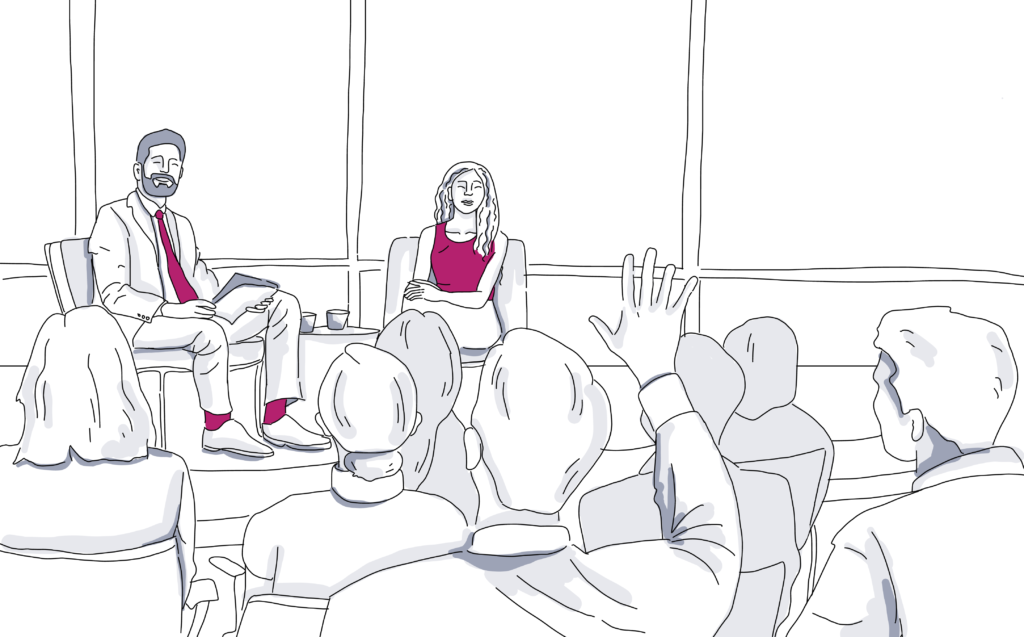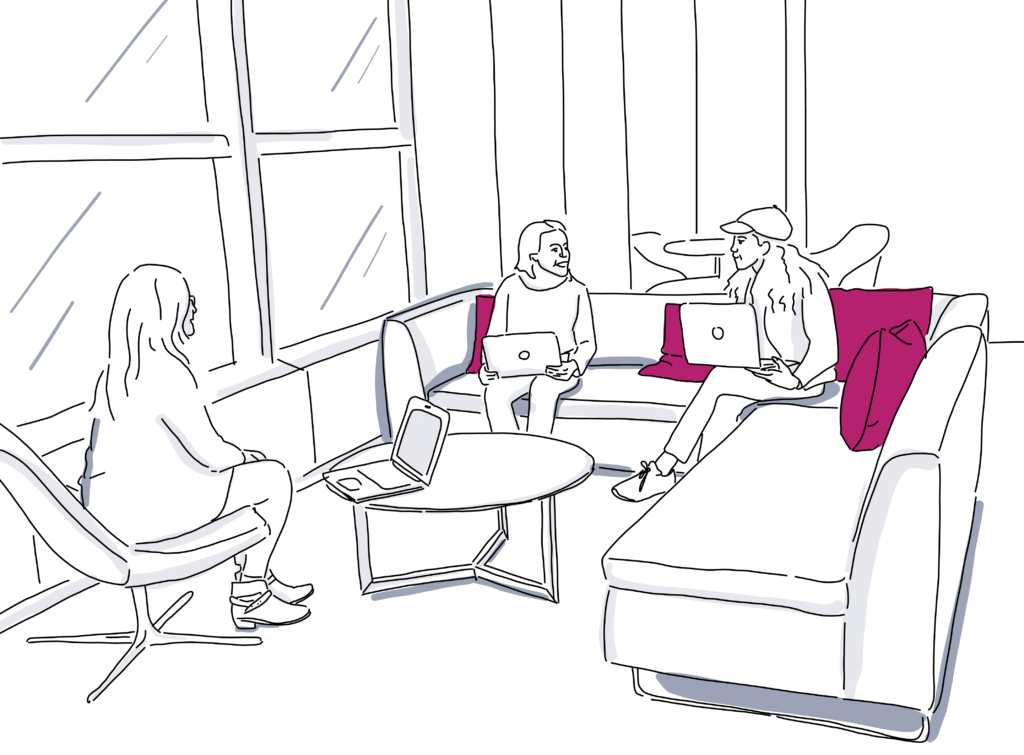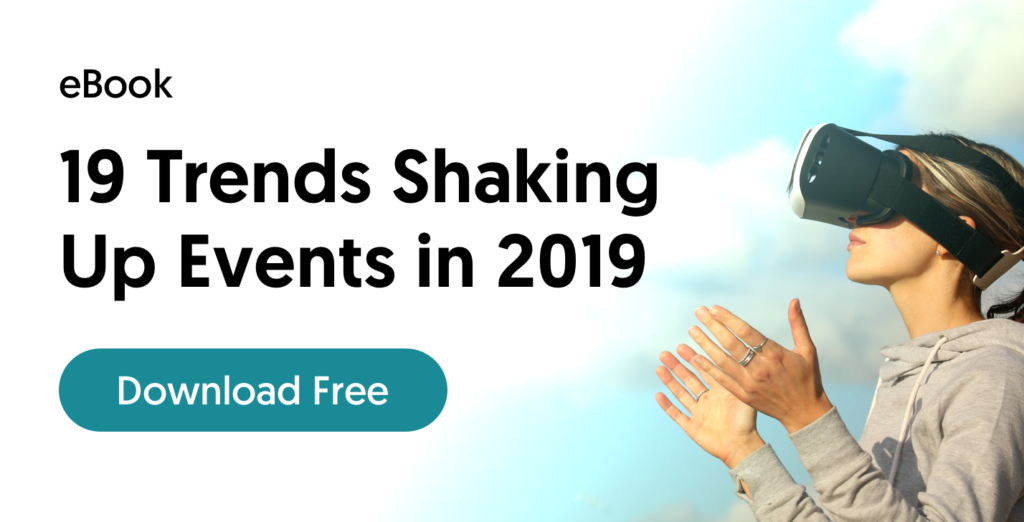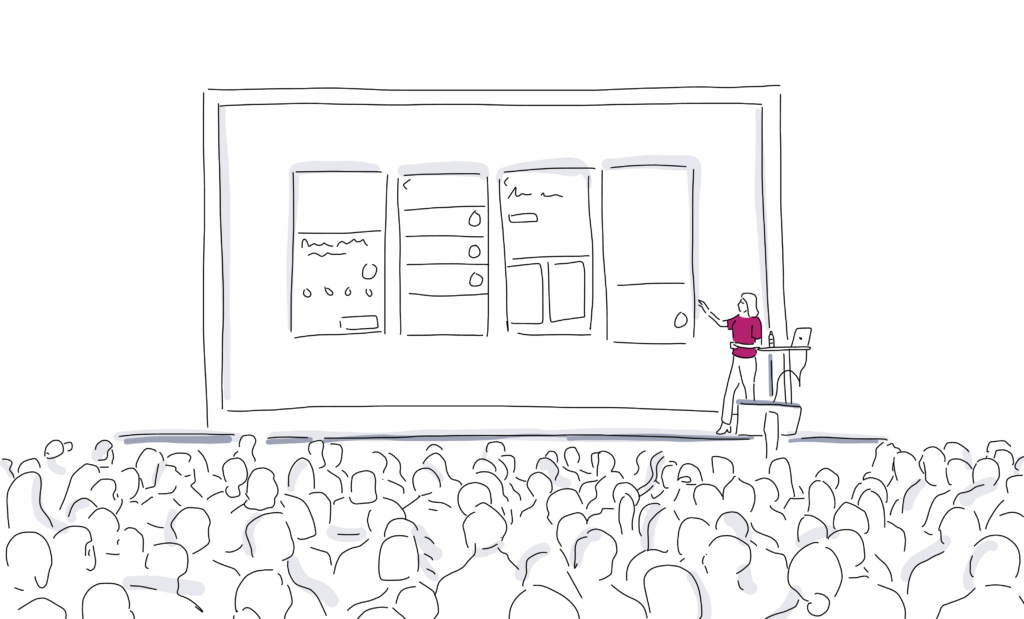
Wednesday Wisdom: The Best Live Q&As Have These 5 Things in Common
There’s no shortage of guides for presenters planning their talks and live Q&A sessions. (Universal tip #1: Prepare.) But this guide is for you, the event planner. To deliver a Q&A that’s organized, on-time, and engaging, you must prepare in advance. ˜Winging it’ is not an option.
At their best, live Q&As can be memorable, useful, and entertaining. But at their worst, they can be the weakest section of a meeting or presentation”and, unfortunately, the last impression the speaker leaves on the audience. As a planner, it pays to know the most predictable ways that meeting and presentation Q&As go off-track. The most common Q&A problems include:
- Running too long: This happens if too many people in the audience have questions, or a single audience member monopolizes time with a rambling question.
- Going too short: This can happen if the presentation runs over its allotted time and cuts into Q&A time, or if too little time is built into the schedule for the Q&A
- Low or off-target participation: This occurs when audience questions are off-topic and rambling, are only interesting to the questioner, or are statements masquerading as questions.
Use these 5 tips to create smooth and informative Q&A sessions that will help presenters”and your event”shine.

1. Help craft the Q&A format with the speaker
In the traditional format, the audience Q&A period happens at the end, and the rule of thumb is that it should be no longer than 20 minutes. However, if the presentation itself is long”more than 45 minutes”consider dropping in another Q&A in the middle to break things up.
A traditional Q&A period has a lot to recommend it: A slight shift in format and energy, for example, and a chance for the presenter to expand in ways of interest to the audience. But for event planners looking to think outside the box, there are nontraditional approaches to consider.
Nontraditional Q&A format examples:
Small-group breakout
What it is: Break the attendees into small groups to discuss their thoughts and questions before the Q&A. People will hash out their ideas and clarify any points of confusion or areas where they would like to extend their knowledge. Consider providing pen and paper so that people can jot down their questions, too.
Why it’s good: This format can lead to some well-thought-out questions. People appreciate the chance to prepare, and everyone in the audience wins when the questions are clear. Small-group breakouts also give event-goers the chance to talk with other attendees, encouraging networking and connection on a specific subject. Finally, the presenter can circulate during the breakouts to listen to discussions, giving them the chance to bring up things they hear and would especially like to address.
Inverse Q&A
What it is: In the Harvard Business Review, Thomas Wedell-Wedellsborg describes an Inverse Q&A, in which the presenter asks a question and audience members discuss the question with someone nearby. A good question will help the participants move their understanding forward or help them think about how to apply what they have learned while the info is very fresh. Wedell-Wedellsborg suggests questions like, For you, what was a key take-away from this session? or What might you do differently going forward?
Why it’s good: This format allows attendees to begin working with the information and making it their own. Like the small-group breakout, the inverse Q&A also allows people to network, but it has a much smaller footprint on the agenda since a Q&A doesn’t usually follow. This is a good fit for presentations with a short or moderate time slot that might feel too brief for a full Q&A.
Finally, remember what Jerry Seinfeld pointed out in a classic bit: Speaking in front of a crowd is considered the number one fear of the average person…Number two is death! This means to the average person, if you have to be at a funeral, you would rather be in the casket than doing the eulogy. Inverse Q&As remove the specter of a fate worse than death.
Closing remarks after the Q&A
What it is: After the Q&A, the presenter closes with some combination of summary and extension. They might deliver a wrap-up that reviews the crucial points, describes an exciting application of their information, or tells a quick anecdote that illustrates the utility of their approach. These closing remarks should be brief.
Why it’s good: This format returns control of the room to the presenter, giving them the chance to create the final impression. The speaker can underscore key points or get the attendees thinking in new ways, while leaving them with a feeling of understanding, curiosity, or excitement”all of which can be hard to assure with a live Q&A.
No Q&A at all
What it is: Just what it sounds like: Don’t offer a Q&A option.
Why it’s good: Some presentations are better off without them”could yours be one? TEDx rules specify that their talks have no audience Q&A. Instead, the goal of the event is for participants to take in ideas, ponder them, and draw their own conclusions.
2. Know audience interaction tech trends and the latest Q&A apps
Gone are the days when a Q&A session meant an event organizer running a mic around the room or having people form lines down at mics near the stage. Technology can be fantastic for keeping Q&As streamlined, on-track, and on-topic. Tech tools encourage audience participation, focused questions, and, in some cases, removes the ˜Seinfeld problem’ of asking people to speak aloud publicly.
First, make sure the event WiFi is up to the job at your venue so it can manage the technology glitch-free. Then discuss tech options with presenters. Experienced speakers may have their preferred technology, but you must be knowledgeable about the latest audience interaction tech trends in order to guide beginning presenters. The latest and greatest Q&A tech solutions include:
Social walls
Social walls display relevant content pulled from social sites like Twitter, Instagram, and Facebook. To use a social wall you just need the aggregation software and a way to display the stream, like a digital display or a projector.
Social walls are great for audience engagement and amplifying event reach, but consider applying them to Q&As, too. People love to see themselves”or their tweets”on the big screen, and social walls also help them remember to use the right hashtag. And when Q&A questions are posted via social media, your event buzz grows. At live-streamed events, social walls can level the playing field between audience members who are there in person and remote attendees.
There are many tools out there for social walls. Hootfeed by Hootsuite will display a customized selection from your Twitter stream that is great for Q&As. Glisser also offers customizable Twitter displays that can be moderated, and”in conjunction with its app”allows attendees to share slides via Twitter.
Polling and Q&A apps
There are many apps specifically designed to help with audience engagement at presentations and meetings, including Q&As. Two of the biggest are Metimeter and Slido. Neither one requires audience members to download an app before the presentation. Instead, attendees to go a URL and put in an event-specific code.
Both allow users to submit and vote on questions before the presentation, helping the attendees start thinking about the material and letting the presenter get a jump on preparation. Talk with the presenter about what they would want audience members to ask”this is a great opportunity to seed a couple of relevant questions.
During the presentation, audience members can also submit questions and vote on which they would like the presenter to answer. This keeps the questions relevant to the greatest number of people. These apps also let the presenter flip the Q&A script with live polling”asking the audience a question that they answer on their smartphones.
Apps that turn smartphones into mics
At many events, attendees will have smartphones with them, so phones-into-mics sounds great. The downside is in the management: Every attendee’s phone/mic cannot be active at once.
A system called Crowd Mics by Biamp addresses that problem with an iPad app that controls which mics are active. Crowd Mics requires a special piece of hardware that plugs into the sound system, and it also requires attendees to download a free app. If you want people to download the app, have the download information on attendee confirmation emails or on slide as they come enter the presentation. (This platform also offers live polling and comment functions.)
It is also possible to connect your phone to a Bluetooth speaker”a good backup option for the ultra-prepared event planner. If the mic or the sound system breaks and you are incredibly familiar with the hardware and software involved, then you’ve got yourself a stopgap while the A/V gets fixed. The drawbacks are similar to those with a traditional mic”you need to get the mic to people or people to the mic”but in this case, that mic is your phone. So you probably want a bump-proof case on there.
Tossable mics
Soft, cushioned tossable mics like Catchbox have been taking live Q&As by storm. They eliminate the time consuming mic pass, and the line of nervous audience members behind the mic near the stage.
Also, they’re totally fun.

3. Brief your team and rehearse for a smooth Q&A
Depending on the event type and size, your presentation team may include yourself, the speaker, a moderator, and a stage manager.
If the presentation has a moderator, brief them early in the process. Moderators need to know the planner’s overall goal for the event: What they want attendees to know, and how should attendees feel by the end of the presentation and Q&A? Who are the attendees; what are their needs, hopes and fears?
Moderators also need information about the speaker or speakers, and any subjects they welcome delving into more deeply or prefer sidestepping completely. In a panel presentation on neuroscience research, for example, it’s helpful if the moderator knows the panelists want to speak on the implications and potential applications of their research, but prefer steering clear of how mice were used in the research.
Finally, make sure the moderator knows and is familiar with the tech. This way they can stay at the helm throughout the Q&A, and understand how long it takes poll responses and new questions to appear.
With the presenter, discuss plans to stick to the presentation and Q&A time limit. If there are more questions than time allows, will there be a hashtag that people can use or a Facebook group they can join to continue the discussion? If not, something as simple as a slide with the speaker’s contact information can be a handy cue that the program is wrapping up.
You will also want to find out ahead of time whether the presenter is comfortable talking to audience members who are running long, rambling, telling stories rather than asking questions, or speaking unclearly. If the speaker is already comfortable handling those scenarios, your job there is done. If the event will have a moderator, agree on scenarios where the moderator should step in.
If there is no moderator and the speaker is not yet comfortable and experienced with these situations, give them some practice. Role-play the rambling audience member, and they can practice guiding you gently and kindly to ask the question. If that tactic doesn’t work, they can simply pivot to a related topic they would like to speak on. Ask whether the speaker would be open to questions and comments so that the inevitable audience members with something to say”but no specific question”can finish their statement and simply be thanked, with minimal awkwardness.
Even though you have systems to streamline communication with your event team, it’s worth it to meet in person with the speaker, the moderator, and the stage manager before the session. Go over the order of events, the time expectations for each portion, and the rules. When it comes to keeping Q&As inside their time limits, there’s no substitute for good old-fashioned expectation setting and establishing signals beforehand.
4. Debrief your team to fine-tune future Q&As
If you’re interested in elevating your event Q&As, make debriefing a habit”-with your team, your presenter, or just yourself. Pay attention to what went well and what didn’t. If there is video footage, review it: Did the Q&A ever get off-track, hostile, or confusing? Was it hard to hear questions because of technical issues, resulting in irritated questioners? Did timeline concerns mean that plenty of people didn’t get to ask their questions and walked away disappointed?
What could you or the presenter have done differently? Possibly a new tech option is in order for next time, or more time allotted for a run-through so everyone is comfortable with the format and technology.
Then, the greater challenge”were there points during a Q&A where it COULD have gotten off-track, hostile, or confusing, but didn’t? How did the speaker keep control of the session? Perhaps they used humor, pivoted to a prepared answer on a related topic, or put up a slide with their contact information and inviting the questioner to get in touch afterwards. These can inform your future Q&A prep, and any guidance you offer presenters and your team.
As you build a repertoire of Q&A experience, you’ll develop a sense of what structures work best and become adept at learning the needs of your speakers early in the process so you can set the stage for success.

5. Spell out expectations for your audience
Unfortunately, don’t assume every audience member is capable of being succinct, or even learned their manners. This is why Broadway theaters ask audience members to turn off their phones before the curtain goes up. For your Q&A, clarify guidelines to your audience repeatedly, such as in the event itinerary email and event-day program, and on a slide at the beginning of the Q&A. Possible directives to include:
- Think about your questions in advance.
- Keep your questions short.
- Be considerate of the entire audience.
- Please avoid statements.
Establishing boundaries in advance reduces the chances people will overstep them. It also minimizes the awkwardness that occurs when an audience member needs reminding”because (almost) everyone is on the same page.
Q: How will you head off common Q&A problems and keep this dynamic part of any event on track and organized?
A: Bookmark this article and use these five tips!
Developing a specialty in corporate events”or interested in doing so? Read our guide to landing corporate event planning clients. Or, kick back and educate yourself with these top event planning videos.

